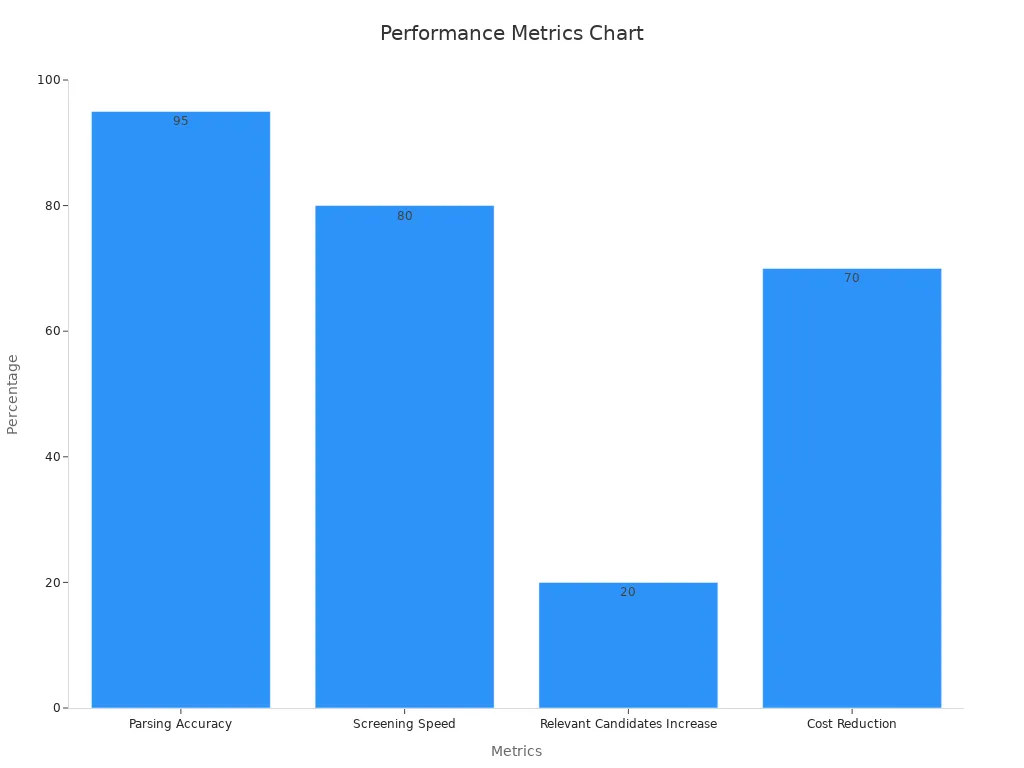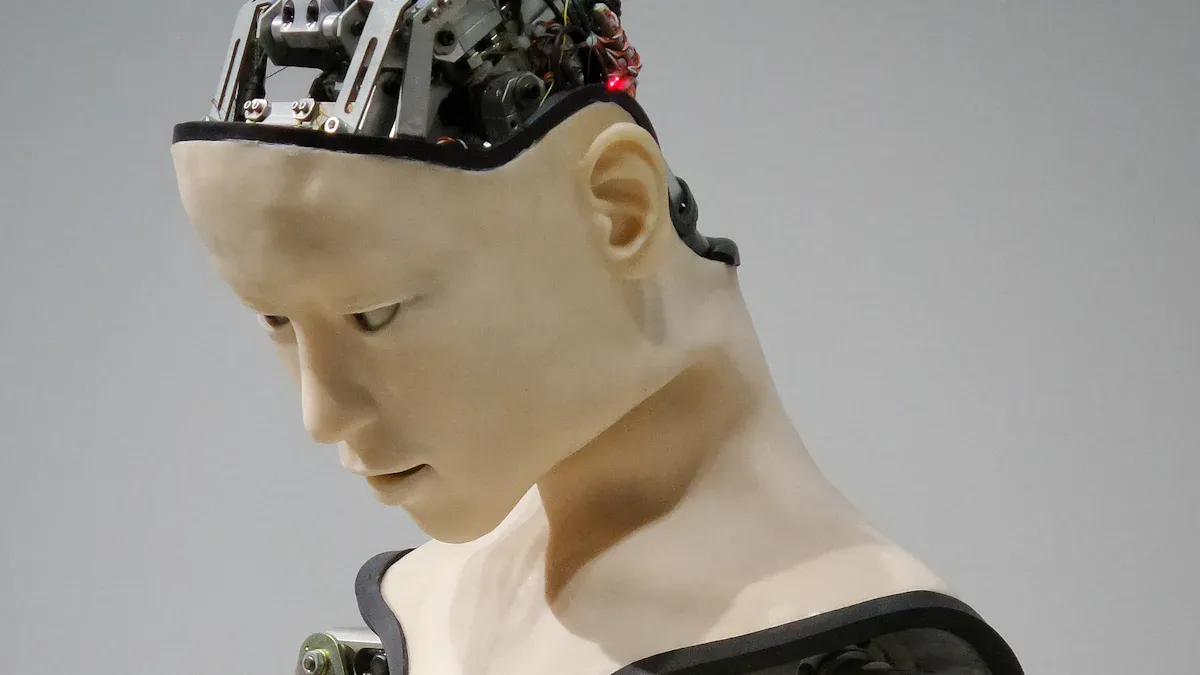What Is Automated Resume Parsing and How Does It Work in 2025

Automated resume parsing uses artificial intelligence to analyze resumes and extract key details like skills, experience, and education. It plays a crucial role in recruitment by simplifying the hiring process. Instead of manually reviewing hundreds of resumes, you can rely on this technology to screen applications quickly and accurately.
In 2025, its importance continues to grow. Studies show that automated tools can reduce candidate screening time by up to 75%. Additionally, 95% parsing accuracy ensures reliable data extraction, while 80% faster screening speeds up hiring decisions. With nearly 98% of Fortune 500 companies using applicant tracking systems, automated resume parsing has become a cornerstone of modern recruitment.
Key Takeaways
Automated resume parsing uses AI to read resumes fast. It saves up to 75% of the time spent on screening.
It works with Applicant Tracking Systems (ATS) to make data entry easier and hiring faster.
It is 95% accurate, so it gives correct information for better hiring choices.
It can read resumes in many languages, helping companies find diverse workers and be more inclusive.
Picking the best resume parsing software is important. Focus on accuracy, speed, and easy use.
How Automated Resume Parsing Works

Uploading Resumes into the System
You begin the process by uploading resumes into the parsing system. Candidates typically submit their resumes during the job application process. The system accepts various formats, including PDFs, Word documents, and even scanned images. Advanced tools use Optical Character Recognition (OCR) to extract text from image-based resumes. Once uploaded, the parser automatically extracts essential details such as contact information, skills, work experience, and education history.
The system then converts this data into a machine-readable format, such as CSV files or database fields. Using contextual and statistical analysis, the parser matches candidates to job descriptions. This step ensures that qualified candidates are shortlisted based on their credentials and the job requirements.
Extracting Key Information with AI
Automated resume parsing relies on AI-powered tools to extract key information efficiently. These tools analyze resumes to identify critical details like job titles, years of experience, and certifications. Natural Language Processing (NLP) enables the system to understand the context of the information, ensuring accurate extraction.
Evidence | Description |
|---|---|
AI-Powered Tools | Quickly extract key information, improving hiring efficiency. |
Contextual Understanding | NLP enhances the system's ability to grasp resume details. |
Ensure precision by understanding resume structure and context. | |
Machine Learning Adaptation | Learn from diverse data to handle various formats and languages. |
Continuous improvement through machine learning allows the system to adapt to new resume formats and languages, enhancing accuracy over time. This ensures that recruiters receive standardized and reliable data for candidate evaluation.
Organizing Data into Structured Categories
After extracting information, the system organizes the data into structured categories. These categories include contact details, skills, education, and work history. This structured approach streamlines workflows and automates repetitive tasks, saving time and effort.
Streamlined Processes: Optimized workflows increase efficiency.
Improved Data Consistency: Standardized formats ensure accurate reporting.
Enhanced Data Integrity: Validation processes promote reliability.
Elimination of Redundancy: Centralized storage reduces duplication.
Easier Data Sharing: Structured data facilitates collaboration.
Organizing data also enhances security and compliance. Access controls and encryption protect sensitive information, while backup strategies prevent data loss. These measures build trust with stakeholders and ensure smooth recruitment operations.
Integrating with Applicant Tracking Systems (ATS)
Integrating resume parsing technology with Applicant Tracking Systems (ATS) has revolutionized recruitment workflows. This integration allows you to automate data entry and standardize resume information, saving time and reducing manual errors. When a candidate submits their resume, the parser extracts key details and seamlessly transfers them into the ATS. This ensures that all candidate profiles are stored in a consistent format, making it easier for you to search, filter, and rank applicants.
Modern ATS platforms leverage APIs to enable real-time data parsing. This means that as soon as a resume is uploaded, the system processes it instantly and updates the candidate database. You can then access features like automated candidate ranking, which uses AI to match applicants to job requirements. These advancements enhance the efficiency of your hiring process by helping you focus on the most qualified candidates.
A case study highlights how AI-powered resume parsing has transformed traditional ATS platforms. By integrating advanced parsing technologies, companies have streamlined their recruitment workflows and improved hiring outcomes. For example, automated data entry eliminates repetitive tasks, while standardized resume formats ensure consistency across all applications. This makes it easier for you to compare candidates and make informed decisions.
Tip: Look for ATS platforms that offer seamless integration with resume parsers. Features like real-time parsing and candidate ranking can significantly improve your recruitment efficiency.
The integration of resume parsing with ATS also supports scalability. Whether you're hiring for a small team or managing global recruitment, this technology adapts to your needs. It simplifies the process of handling large volumes of resumes, ensuring that no qualified candidate slips through the cracks. By adopting these tools, you can stay ahead in the competitive hiring landscape of 2025.
Benefits of Automated Resume Parsing
Faster Resume Screening and Shortlisting
Automated resume parsing significantly reduces the time it takes to screen and shortlist candidates. Instead of spending hours manually reviewing resumes, you can rely on AI-powered tools to process applications in minutes. These tools analyze resumes, extract relevant details, and match candidates to job requirements almost instantly.
For example, companies like Unilever and Hilton Worldwide have reported remarkable efficiency improvements. Unilever reduced its time-to-hire by 75%, while Hilton cut manual screening time by over 85%. This speed allows you to focus on engaging with top candidates rather than getting bogged down in administrative tasks.
Tip: Use resume parsing software that integrates with your ATS to further streamline the process and save even more time.
Improved Accuracy and Reduced Errors
Automated resume parsing ensures high accuracy in extracting and organizing candidate information. Advanced algorithms and machine learning models adapt to various resume formats, reducing the chances of errors caused by manual data entry.
Metric | Value |
|---|---|
95% | |
Screening Speed | 80% Faster |
Relevant Candidates Increase | 20% More Relevant |
Cost Reduction | Up to 70% |
These metrics highlight how automated tools improve the quality of your recruitment process. By minimizing errors, you can trust the data you receive and make better hiring decisions.

Multilingual Parsing for Global Recruitment
In today’s global job market, multilingual parsing has become essential. Automated resume parsing tools can now process resumes in over 40 languages with high accuracy. This capability helps you overcome language barriers and expand your talent pool.
According to the report "Talent Matchmaking: How Multi-Format Parsing Transforms Recruitment," multilingual parsing not only enhances efficiency but also reduces unconscious bias. AI-powered tools objectively extract data from resumes, ensuring hiring decisions are based on skills rather than formatting or language. This approach improves compliance with hiring regulations and fosters diversity in your workforce.
By adopting multilingual parsing, you can engage candidates from different regions and ensure a fair recruitment process. This is especially important for companies operating in multiple countries or hiring for remote roles.
Enhanced Candidate Matching with AI
AI has revolutionized how you match candidates to job roles. Automated resume parsing now uses advanced algorithms to analyze resumes and job descriptions. These systems identify the best matches by comparing skills, experience, and qualifications. This approach ensures that you focus on the most suitable candidates.
Modern tools rely on Natural Language Processing (NLP) to understand the context of resume information. For example, NLP can differentiate between a candidate's current and previous job roles. Machine learning further enhances this process by improving accuracy over time. As the system processes more data, it becomes better at evaluating candidates.
Here are some key benefits of AI-enhanced candidate matching:
Contextual Understanding: NLP helps the system grasp the meaning behind resume details.
Improved Accuracy: Machine learning refines the system, leading to better evaluations.
Faster Efficiency: AI speeds up the shortlisting process, saving you valuable time.
Benefit | Description |
|---|---|
Fairer Candidate Selection | AI resume parsers judge candidates based on data, reducing personal bias. |
Improved Matching Accuracy | AI algorithms analyze job descriptions and candidate profiles to find the best matches. |
Time and Cost Efficiency | Companies can reduce resume review time from 30 hours to 5 hours and cut hiring costs significantly. |
A study by Deloitte found that AI-enhanced recruitment technologies improve the quality of hires by 20%. This means you can build stronger teams while reducing hiring time and costs. Automated resume parsing ensures that your recruitment process is both efficient and effective.
Tip: Use AI-powered tools to eliminate bias and improve candidate matching accuracy.
Challenges of Automated Resume Parsing
Issues with Non-Standard Resume Formats
Non-standard resume formats can create significant challenges for automated parsing systems. While machine learning-based parsers adapt to recognize patterns in various layouts, some resumes still pose difficulties. Candidates often use creative designs, such as infographics or unconventional fonts, to stand out. These unique layouts can confuse AI tools, leading to incomplete or inaccurate data extraction.
Machine learning algorithms attempt to identify patterns in diverse resume formats.
Creative designs, like charts or images, may disrupt the parsing process.
To address this, you should choose parsing software that continuously learns and improves. Advanced tools with Optical Character Recognition (OCR) capabilities can better handle non-standard formats. However, even with these advancements, no system guarantees 100% accuracy when faced with highly creative resumes.
Addressing Algorithmic Bias in Parsing
Algorithmic bias remains a critical concern in automated resume parsing. AI systems often reflect the biases present in their training data. For example, a Microsoft study in 2019 revealed that language models like Word2Vec could produce biased associations. Researchers found that these models linked men with technical roles and women with domestic roles, reinforcing stereotypes.
In 2018, Amazon faced a similar issue when its AI-driven recruitment tool favored male candidates. The algorithm, trained on ten years of resumes, learned from a dataset dominated by male applicants. This led to discrimination against female candidates, highlighting the risks of biased training data.
To minimize bias, you should use parsing tools that prioritize fairness. Data-driven decision-making and regular audits of AI systems can help reduce unconscious bias. Additionally, integrating these tools with applicant tracking systems ensures a more inclusive hiring process.
Ensuring Data Privacy and Security
Resume parsing systems handle sensitive personal information, making data privacy and security a top priority. These tools process details like names, addresses, and employment histories, which must remain confidential. Compliance with regulations such as GDPR and CCPA is essential to protect candidate data.
Parsing software must adhere to strict privacy laws to avoid legal issues.
Some regions impose stringent regulations, which can slow down adoption.
You should select software with robust encryption and access controls. Regular updates and audits can further enhance security, ensuring that your recruitment process remains compliant and trustworthy.
Choosing the Best Resume Parsing Software in 2025
Key Features: Accuracy, Speed, and Integration
When selecting resume parsing software, prioritize tools that excel in accuracy, speed, and integration. Accuracy ensures the system extracts data correctly, even from complex resumes. Some parsers in 2025 achieve up to 99% accuracy, making them highly reliable. Speed is equally important. Modern tools process resumes 80% faster than traditional methods, allowing you to screen candidates in minutes.
Integration with existing systems, such as Applicant Tracking Systems (ATS), is another critical feature. Many software options now offer seamless integration, enabling you to transfer parsed data directly into your ATS or HR platforms. This eliminates manual data entry and ensures consistency across your recruitment process.
Feature | Evidence |
|---|---|
Accuracy | Up to 99% accuracy achieved by some parsers. |
Speed | Resume parsing can be 80% faster than traditional methods. |
Integration | Many software options integrate seamlessly with ATS and HR systems. |
Tip: Look for tools that support bulk imports and generate meaningful candidate summaries to further enhance efficiency.
Scalability for Growing Recruitment Needs
As your organization grows, your recruitment needs will expand. Choose a resume parsing tool that scales effortlessly to handle increasing volumes of resumes. The global market for resume parsing software is projected to grow from $1.2 billion in 2018 to $2.8 billion by 2030, driven by the adoption of AI in recruitment. This growth highlights the importance of selecting scalable solutions.
Scalable tools adapt to your needs, whether you're hiring for a small team or managing global recruitment. They also offer customization options, allowing you to tailor the software to industry-specific requirements. For example, you can configure the parser to recognize unique qualifications or jargon relevant to your field.
Ensure the tool integrates well with existing systems.
Opt for solutions that comply with data privacy regulations.
Evaluate scalability to handle increasing resume volumes.
User-Friendly Design for Recruiters
A user-friendly interface simplifies the recruitment process for your team. Look for software with intuitive dashboards and easy navigation. Recruiters should be able to upload resumes, view parsed data, and generate reports without extensive training.
User-friendly tools also improve collaboration. Features like shared access and real-time updates allow team members to work together seamlessly. Additionally, a well-designed system reduces errors and ensures a smoother workflow.
Note: Evaluate the user experience for both recruiters and candidates to ensure the software meets everyone's needs.
Vendor Support and Regular Updates
Choosing resume parsing software with reliable vendor support and regular updates ensures smooth operations and long-term success. Vendors play a crucial role in helping you resolve technical issues, optimize system performance, and adapt to evolving recruitment needs.
Why Vendor Support Matters
Strong vendor support guarantees that you can rely on experts when challenges arise. Whether you encounter a system error or need assistance with integration, responsive support minimizes downtime and keeps your recruitment process on track.
24/7 Availability: Look for vendors offering round-the-clock support to address urgent issues.
Dedicated Account Managers: Some vendors assign specialists to guide you through setup and troubleshooting.
Knowledge Resources: Access to tutorials, FAQs, and webinars helps you maximize the software’s potential.
Tip: Evaluate vendor reviews and testimonials to ensure their support team is dependable and proactive.
The Importance of Regular Updates
Regular updates keep your software compatible with the latest technologies and recruitment trends. Updates improve parsing accuracy, enhance security, and introduce new features that streamline your workflow.
Benefit | Description |
|---|---|
Improved Accuracy | Updates refine algorithms to handle new resume formats and languages. |
Enhanced Security | Regular patches protect sensitive candidate data from emerging threats. |
New Features | Vendors often add tools like real-time analytics or advanced AI matching. |
Outdated software can lead to errors, inefficiencies, and security vulnerabilities. By choosing a vendor committed to frequent updates, you ensure your system stays ahead of industry changes.
Note: Ask vendors about their update schedule and whether upgrades are included in your subscription plan.
Making the Right Choice
When evaluating resume parsing software, prioritize vendors with a proven track record of support and innovation. Reliable vendors help you adapt to challenges and maintain a competitive edge in recruitment.
The Future of Automated Resume Parsing in 2025

Advancements in AI and Machine Learning
AI and machine learning are transforming automated resume parsing into a smarter and more efficient tool. These advancements allow systems to go beyond simple keyword matching. They now analyze the context and semantics of resumes, providing a deeper understanding of candidates' skills and experiences. Enhanced natural language processing (NLP) plays a key role in this evolution. It enables the system to interpret complex resume content with greater accuracy.
Predictive analytics is another game-changer. It helps you forecast a candidate's potential success based on historical data. For example, AI can identify patterns in past hires to predict which applicants are likely to excel in specific roles. This technology also supports skills-based hiring, which aligns candidates' abilities with job requirements. As a result, you can make smarter hiring decisions and improve employee satisfaction.
Organizations are also prioritizing diversity and inclusion. Nearly 78% of companies now focus on unbiased recruitment tools. These tools ensure fair evaluations by valuing candidates for their skills rather than their career history. This shift reflects a broader trend toward creating more inclusive workplaces.
Real-Time Parsing and Analytics
Real-time parsing is revolutionizing how you process resumes. Modern systems analyze resumes instantly, allowing you to update candidate databases in seconds. This speed reduces time-to-hire by up to 50%, giving you a competitive edge in recruitment. Real-time analytics further enhances this process by providing actionable insights. For instance, you can track hiring trends, measure candidate engagement, and identify skill gaps within your talent pool.
Data-driven HR strategies are becoming the norm. Companies using analytics report higher retention rates and improved employee experiences. Skills-based hiring, supported by real-time data, also boosts productivity and reduces attrition. These tools empower you to make informed decisions quickly, ensuring you focus on the most qualified candidates.
Trend | Insight |
|---|---|
Resume Parsing Growth | AI-powered tools are automating resume screening, reducing time-to-hire by 50%. |
Skills-Based Hiring | Companies using skills-first approaches report higher retention and satisfaction. |
Remote Work Strategies | Hybrid models boost productivity by 20% and reduce attrition by 30%. |
Data-Driven HR | AI and analytics enhance hiring accuracy and employee experiences through predictive tools. |
Personalized Candidate Matching
Personalized candidate matching is reshaping recruitment by focusing on individual strengths. AI-powered systems analyze resumes and job descriptions to identify the best matches. These tools consider factors like skills, experience, and qualifications, ensuring you connect with the right candidates. Advanced algorithms now achieve up to 95% accuracy, a significant improvement over traditional methods.
This technology also reduces manual screening by 75%, saving you time and resources. By understanding the context of resume details, AI ensures fairer evaluations. For example, it can differentiate between a candidate's current and previous roles, providing a clearer picture of their career trajectory. Companies using these tools report a 20% improvement in hire quality, highlighting their effectiveness.
Diversity remains a priority for many organizations. Nearly 79% of companies emphasize equity and inclusion in hiring. Personalized matching supports this goal by eliminating biases and focusing on skills. According to industry experts, inefficiencies in traditional parsing cost U.S. businesses $1.5 million annually. By adopting advanced systems, you can avoid these losses and build stronger teams.
Integration with Emerging Recruitment Tools
Emerging recruitment tools are reshaping how you hire talent. By integrating automated resume parsing with these tools, you can create a seamless hiring process that saves time and improves results. Modern recruitment platforms now offer features like advanced search, candidate matching, and real-time analytics. When paired with resume parsing, these tools enhance your ability to find the right candidates quickly.
Why Integration Matters
Integrating resume parsing software with recruitment tools optimizes data flow. It ensures that parsed information moves smoothly between systems, reducing manual work. Automation speeds up hiring and improves the quality of your decisions. Proper data validation also plays a key role. It ensures that the information extracted from resumes is accurate and ready for analysis.
Key Aspect | Description |
|---|---|
Integration Importance | Thoughtful integration of resume parsing software is crucial for optimizing data flow. |
Automation Benefits | Automating key tasks leads to improvements in hiring speed and quality. |
Data Validation | Proper data validation enhances the effectiveness of recruitment technologies. |
Features of Emerging Tools
Modern recruitment tools offer advanced search and matching capabilities. These features allow you to filter candidates based on specific skills or experiences. Matching algorithms have become more nuanced and unbiased, ensuring fair evaluations. For example, AI-powered systems can analyze resumes and job descriptions to identify the best matches without relying on keywords alone.
Advanced search and filtering options.
Development of unbiased matching algorithms.
Real-time analytics for tracking hiring trends.
Tip: Choose tools that integrate seamlessly with your resume parser. This ensures a smooth workflow and reduces errors.
By adopting these technologies, you can stay ahead in the competitive hiring landscape. Integration not only simplifies your recruitment process but also helps you make smarter decisions based on reliable data.
Automated resume parsing has become an essential tool in modern recruitment. It saves time, reduces costs, and improves hiring accuracy by processing thousands of resumes in minutes. With nearly 98% of Fortune 500 companies using applicant tracking systems, this technology ensures seamless integration and data-driven decision-making. Advanced features like multilingual parsing and AI-powered analytics also enhance global hiring and diversity initiatives.
Staying updated with advancements in 2025 is crucial. Tools now offer 95% parsing accuracy and 80% faster screening, making them indispensable for recruiters. By adopting these innovations, you can streamline your hiring process and focus on building stronger, more inclusive teams.
FAQ
What is the difference between resume parsing and keyword matching?
Resume parsing extracts structured data like skills, experience, and education from resumes using AI. Keyword matching only scans for specific words. Parsing provides deeper insights by understanding context, while keyword matching is limited to surface-level information.
Tip: Use parsing tools for better accuracy and candidate evaluation.
Can automated resume parsing handle creative resume designs?
Some parsers struggle with creative formats like infographics or unique fonts. Advanced tools with Optical Character Recognition (OCR) can process these designs more effectively. However, no system guarantees 100% accuracy with highly unconventional layouts.
Note: Encourage candidates to use standard formats for better results.
Is automated resume parsing secure?
Yes, most modern parsing tools comply with data privacy laws like GDPR and CCPA. They use encryption and access controls to protect sensitive information. Always choose software with strong security features and regular updates.
Security Feature | Benefit |
|---|---|
Encryption | Protects candidate data |
Access Controls | Limits unauthorized access |
How does multilingual parsing work?
Multilingual parsing uses AI to analyze resumes in multiple languages. It identifies key details like skills and experience regardless of the language. This feature helps you expand your talent pool and hire globally.
Example: A parser supporting 40+ languages can process resumes from diverse regions.
Can resume parsing eliminate hiring bias?
Automated parsing reduces bias by focusing on skills and qualifications instead of personal details. However, biased training data can still influence results. Regular audits and diverse datasets help ensure fair evaluations.
Tip: Use tools designed to prioritize diversity and inclusion in hiring.
See Also
Effective Ways to Navigate an Applicant Tracking System
Mastering Team Collaboration with Applicant Tracking Systems
Understanding Business Requirements Through Applicant Tracking Systems
Enhancing Onboarding Processes Using Applicant Tracking Systems
From recruiting candidates to onboarding new team members, MokaHR gives your company everything you need to be great at hiring.
Subscribe for more information

